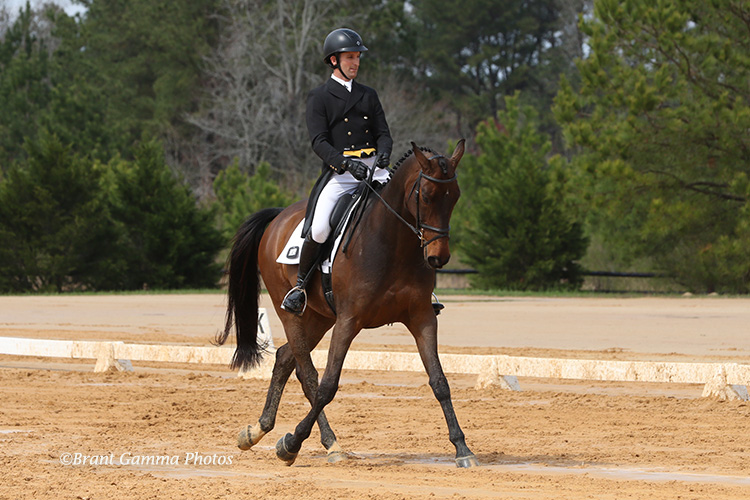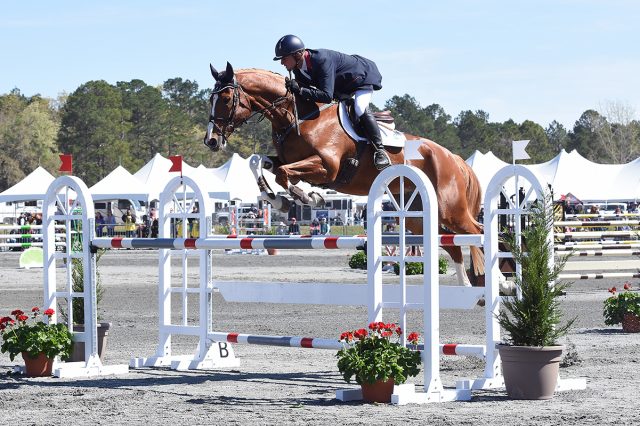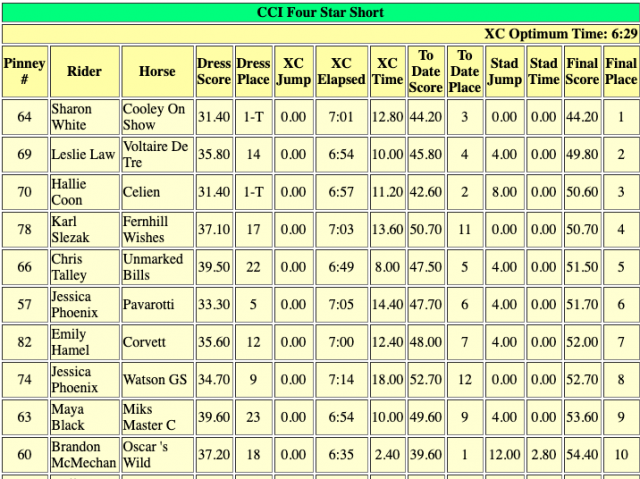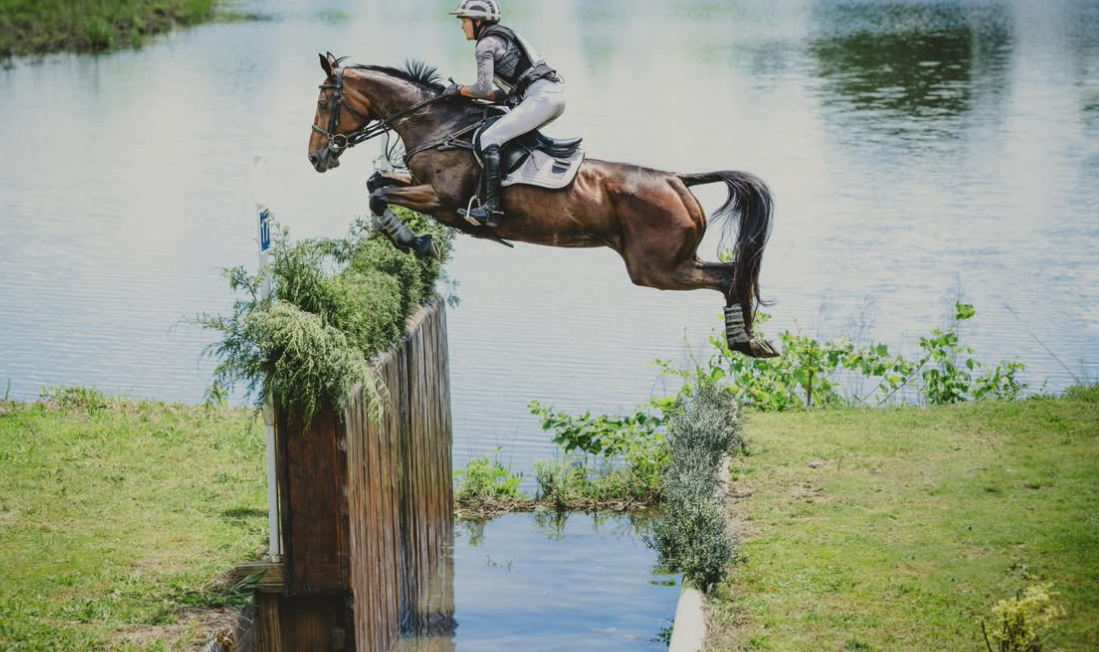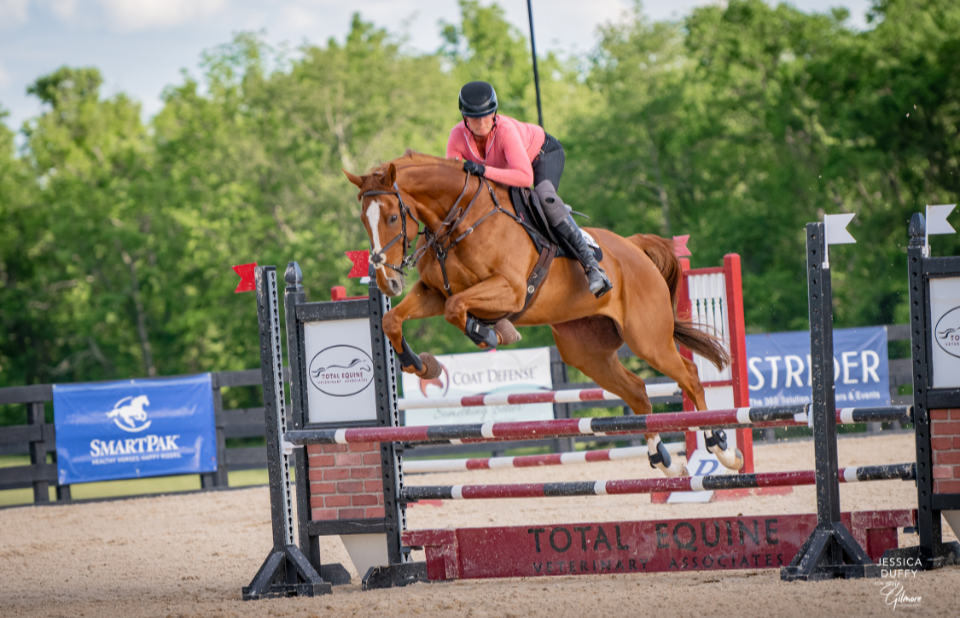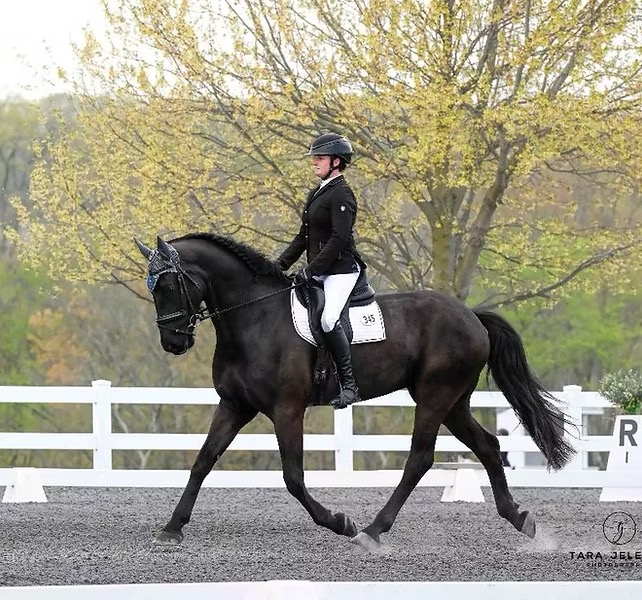Celebrating International Women’s Day may seem incongruous in a rare sport that allows women to compete as equals against men, but we’re all about girlpower here at EN. So to celebrate, we’re taking a look back at some of the remarkable women, both past and present, who have helped to shape the sport of eventing into what it is, and through their own incredible efforts, have given all of us the chance to fly vicariously with them.
Lana duPont Wright

Though equestrian sports are celebrated for their gender equality these days, eventing’s military roots meant that women weren’t always welcome on the competitive battlefield. From 1912 — when eventing first appeared at the Olympics — until 1924, only military officers could contest this topmost echelon of the sport. From 1924, the door was widened to allow male civilians to compete — but it would be another four decades before Olympic eventing would become a level playing field.
All this was to change at the 1964 Tokyo Games, where the sport of eventing would see its first female Olympian.
The daughter of Olympic trapshooter and prolific racehorse owner Allaire duPont, a young Lana duPont was raised in a household that was — possibly unwittingly — fiercely feminist for the era. But it wasn’t just an innate toughness and competitive spirit that Lana would inherit from her mother — a love of horses and the countryside, too, passed from one generation to the next. Lana would spend her formative years in thrall to fox hunting, learning how to cover the Maryland terrain on a collection of Thoroughbreds.
In 1964, she was named to the US equestrian team and travelled to the Tokyo Olympics with her Maryland-bred Mr Wister. Though their competition wasn’t to be without its dramas, they would finish the Games on the podium, having helped the USA to a team silver medal.
Recalling her cross-country round, Lana said: “We fell hard, Wister breaking several bones in his jaw. We were badly disheveled and shaken, but Wister was nonetheless eager to continue. We fell a second time near the end of the course, tripping over another spread. When we finished, we were a collection of bruises, broken bones and mud. Anyway, we proved that a woman could get around an Olympic cross-country course, and nobody could have said that we looked feminine at the finish.”
Lana would go on to help found the US Combined Training Association (now US Eventing), and would compete at World Championship level in combined driving, as well as fostering an interest in competitive endurance riding.
Anneli Drummond-Hay

Anneli Drummond-Hay and Merely-a-Monarch. Photo courtesy of Badminton Horse Trials.
Nearly twenty years after the birth of Badminton Horse Trials – and, really, the birth of the sport in the United Kingdom – a second top-level international event would appear on the scene. The year was 1961, and the extraordinary Burghley estate in Lincolnshire was opening its gates to the best horses and riders in the country, and the people who loved to watch them, too. The pressure to compete — and to compete well — was on.
But for all this, a 24-year-old Anneli Drummond-Hay hadn’t actually had much match practice with her remarkable six-year-old, Merely-a-Monarch, before she put in her entry to the new and prestigious event. Though she had plenty of experience herself, having previously won the Pony European Championships and topping the annual leaderboard of British riders three times, this would be an altogether different challenge. Undeterred, she and the horse — with whom she’d largely contested showjumping, and who hadn’t experienced any water more taxing than a puddle in the lane — set out with one goal in mind: simply come home safely. After all, she hadn’t even intended to enter Monarch, but her intended mount was out of action, and so he would have to do.
They would lead the dressage by 30 marks and, drawn last to go on cross-country, they were greeted by the news that everyone else in the field had had at least one fall, many of them at the Trout Hatchery, where a hole had formed in the footing on the landing side of the jump into the water. With this in mind, Anneli nursed her young horse around the course, choosing the less popular log option into the water and coming home with the only clear round of the day. An unsurprising clear round over the poles the next day meant that victory was theirs by an astonishing margin of nearly 34 points. The next year, they would also take top honours at Badminton — this time, by 42 points.
Afterwards, conscious that her beloved horse was now worth an enormous sum of money, and buoyed on by the fact that women were now allowed onto the Olympic showjumping team, Anneli turned her attention back to jumping coloured poles with considerable success.
Sheila Willcox

Despite her incredible legacy, the late Sheila Willcox wasn’t born into a remotely horsey family. Instead, she once described her household as being “entirely suburban, based on business and academic careers and given to rugger, tennis, and bridge-playing.” Nonetheless, she was inexplicably bitten by the horsey bug, and spent her formative years saving up her pocket money so she could afford pony rides along the beach on holidays. Her parents eventually defected, and she was allowed to join the Pony Club. This, of course, swiftly became the primary focus of her life – so much so that her unwitting father bought her an unbroken pony in order to persuade her to head back to school without a fuss. Sheila was only ten years old at the time but nevertheless, she set about the great new challenge of training the two-year-old ‘Folly’.
Not long after, Sheila discovered the joys of competing – and moreover, the joys of victory. After being awarded her first rosette at a local fair, she vowed to be the very best at riding, saying: “to wear a number, to be called by name into the ring and walk, trot, and canter around with the other ponies – this was halcyon bliss…at the same time I determined that no matter which branch of equestrianism I should eventually take up, I should strive to emulate the leaders.”
A successful junior career riding show hacks followed, after Sheila’s parents deemed showjumping rather too unladylike to be proper. But Sheila wanted more of a challenge and, at the age of seventeen, she came across the sport of eventing. Like many profoundly bonkers teenage girls thereafter, she was instantly committed, and set about on the hunt for a horse that she might be able to turn into an eventing star.
Eventually she found that horse in the form of High and Mighty, or ‘Chips’, a seven-year-old dun by a Thoroughbred stallion and out of a Highland pony/Arab-cross mare. Though neither horse nor girl had any real formal training, Sheila undertook the job with aplomb, consulting a well-worn copy of Dressage by Henry Wynmalen for guidance. They won on their first attempt at eventing, in a Novice (Prelim) class at the now-defunct Hovingham Hall Horse Trials, and the British Horse Society got in touch to suggest that, down the line, Sheila might consider lending the horse to the British team for use at the Olympics.
And here we get to the crux of what really makes Sheila’s legacy so remarkable: she paved the way for women when the sport, though still refreshingly genderless in most spheres, only catered to men for Olympic berths. Impossibly glamorous and relentlessly fierce, Sheila refused to bow down to the whims of the BHS, and she rode as though she had a point to prove – perhaps because she did. As one of eventing’s suffragettes, she made it clear that the ‘lady riders’ could play with the big boys – and she did so by setting a remarkable Badminton record that no one has yet beaten.
In 1955, she began training with Colonel Edy Goldmann, who was one of the first British trainers to promote a German-style focus on dressage. Paired with Sheila’s single-minded competitiveness, the result was formidable, and after a good showing at Harewood Horse Trials, Sheila and Chips were offered a place on the British team at that year’s Turin International. Sheila was the only female rider in the competition…and she won it.
In 1956, after just a year and a half of eventing, she and Chips headed to Badminton. They were placed second after the dressage, and accumulated the maximum number of bonus points in the speed and endurance phases, but even their clear showjumping on the final day couldn’t push them ahead of the legendary Frank Weldon and Kilbarry. They retained that second place all the way through until the bitter end – and overnight, British selector Ted Marsh had bought the horse on behalf of the team. As consolation, Marsh promised that if Chips returned from that year’s Stockholm Olympics in one piece, Sheila would be allowed to take him to Badminton the next year.
As it turned out, Chips didn’t even make it to Stockholm – instead, he went lame whilst in training at Windsor. But Sheila attended the Games herself – not as a competitor, which wasn’t allowed, but as a member of the media, commenting on the action for l’Année Hippique. The British team took gold, but Sheila felt she’d been hard done by: “Harking back to the controversy over allowing women competitors in the three-day event, and without wanting to appear a militant feminist, I still think the element of danger is in ratio to intelligent riding, and that should an unlucky accident happen to a woman instead of a man, she will show equal fortitude and endurance, as well as possibly less sustained shock due to the relief of feminine tears. No one would be surprised to see me passing the finishing post crying bitterly and feeling much better for it, but it would cause something of a furore if [Laurence] Rook or [Frank] Weldon came home dripping tears over Sissi or Kilbarry!”
After the Games, Sheila was able to buy her ‘lame’ horse back from the team. He promptly came sound again, and they won their ’57 Badminton prep run. Then it was time to head to the main event, made doubly special by the fact that Sheila’s 21st birthday fell on cross-country day. Fortunately for her festive spirit, she and Chips found themselves in the lead after dressage and, with a fast clear under their belts, still at the top of the pack by the time her party began at a nearby hotel. The crowning glory of the party was her colossal birthday cake – it was made to look like an elaborate cross-country course, with 21 fences artfully constructed along the top. Around them was a castle, some streams, and some carefully constructed terrain – and, of course, a tiny replica of Sheila and Chips popping over the final fence.
By all accounts, the party was a roaring success. At 3am, Sheila had to forcibly remove the revellers so she could get some sleep – but in true eventing fashion, she was able to get the job done the next day. The Badminton title was hers.
The next year, the remarkable pair took the crown again. This time, they would do it by the widest margin ever seen to date or since – they led the dressage by 22 points and ultimately won an astonishing 47 points clear of the next competitor. That autumn, Sheila and Chips headed to the European Championships in Copenhagen, and won both team and individual gold – this made Sheila the first woman ever to win the Europeans. Afterwards, Sheila gave High and Mighty to Ted Marsh to ‘retire’ into the Heythrop hunting field, but nevertheless, she was able to continue her quest to be the very best. The seven-year-old Airs and Graces had only been eventing for six months by the time he headed to Badminton in ’59, but he won it easily, giving Sheila the last of her unrivalled three consecutive wins. In 1964, she took a fourth title, winning ‘Little Badminton’ – a separate class run over the same course but for horses with minimal winnings – with Glenamoy.
In 1971, Sheila suffered a catastrophic fall at Tidworth Horse Trials, and was left partially paralysed. Determined not to give up riding, she swapped her focus to pure dressage and went on to compete successfully at the Grand Prix level. But she was also an enormously influential figure to the next generation of event riders: one of her rare and notable students was Mary King, who worked her way up to being Sheila’s head girl.
As it turned out, the ferocity of spirit and determination that made Sheila such a formidable competitor made her a notoriously tough employer and trainer, too.
In her 2009 autobiography, Mary King reflected: “my days would begin at 5.30am and, before I even got on a horse, I realised that the stable management was extraordinarily thorough. Mucking out was a very strict procedure; the floor had to be ‘clean enough to eat from’ and you had to move the straw back completely…no more than one pile of poo was allowed in a stable at any one time. Windows were Windolened inside and out once a week and there mustn’t be a cobweb in sight. Sheila Willcox was a perfectionist who left no stone unturned.”
In lessons, too, Sheila demanded the highest standards from her staff: “Sheila would say, ‘don’t you dare fall off!’ and the fact that I was much more scared of her than I was of a rearing and bucking horse made me stick on. It was very educational.” But, says Mary, “my two and a half years there turned out to be fantastic training and the broad base on which I have built my career.”
Lucinda Green

Killaire and Lucinda Green. Photo by Kit Houghton/Mitsubishi Motors Badminton Horse Trials.
The Queen of Badminton? Absolutely. The Queen of Eventing? Many would argue so, and quite compellingly too. Lucinda was just nineteen when she took her first Badminton title in 1973 riding Be Fair, her Pony Club eventer who had taken her to team gold at the ’71 Junior European Championships. Be Fair was out of a mare called Happy Reunion, but he wasn’t planned progeny – in fact, he was borne out of an illicit liaison between the supposedly barren Happy and her field companion. The guilty colt in question would go on to contest Badminton himself – he was Fair and Square, ridden by Sheila Willcox.
Lucinda – then Prior-Palmer – had her first ride around Badminton with Be Fair in ’72. She later recalled in an interview with Debbie Sly, “I walked the course with Mark Phillips, who just kept saying ‘You want to kick here…I should keep kicking here…’ It didn’t seem to matter what type of fence we were looking at, the advice seemed to remain the same: just keep kicking! By the time we got to the end of our course-walk I had a streaming nosebleed from the stress of it all.”
Despite the nosebleed – and a runout at the walls as a result of her slippery leather gloves – Lucinda finished fifth. The following year she and Be Fair would return, and this time, they’d produce a nearly foot-perfect round – just one minor reroute due to an erroneous lack of martingale marred their cross-country, but they escaped penalty and took the title.
In an interview with Country Life, Lucinda said: “It was ridiculous: I was 19, it was my second attempt and the horse, Be Fair, had been my 15th-birthday present. Winning Badminton happens to other people, doesn’t it, but, as I drove home, in my little converted ice-cream van, with Be Fair’s ears just inches behind my own and my dog, Oliver Plum, beside me, I heard on the six o’clock news: ‘Today, Badminton Horse Trials was won by…’”
In 1976, Lucinda took her second Badminton title, but her victory was arguably superseded by the tragic death of her mount, Wideawake. The 16hh gelding (Hereward the Wake x Serenade) had been a tricky character, and Lucinda had poured all her energy into building a partnership with him.
She recounted to Debbie Sly, “Wakey really did not like me very much when our partnership began; he once even squashed me against the partition of the lorry with great purpose to the extent that I had to shout for help, and he seemed to take great delight in being as annoying and unhelpful as possible. He would back you into the corner of the stable and leave you there, he would wait until the mucking out bin was full and then tip it all over the clean floor, and when you tried to put his boots on he would wave his leg around until it connected with your knee or your toe. He was an extraordinary horse; sensitive without being highly strung. Once he galloped loose up the drive; a van was coming down the road and the two collided, sending Wakey flying over the bonnet and onto the other side of the road. He escaped with a few scrapes and bruises but his fear of traffic – the only fear he knew – remained with him always.”
In winning Badminton, it seemed as though all the hard work had come good – as Lucinda put it, “I had finally learnt to ride him as he needed to be ridden.” That required doing as little as possible – Wakey didn’t like to feel even the slightest nudge of his rider’s legs, but instead wanted to be left alone to work things out for himself. As the pair waited to begin their lap of honour, Lucinda leant down to hug her mount’s neck. While she did so, the rest of the top-placed horses and riders duly filed out of the arena in order to allow Lucinda to begin the victory gallop alone, as was customary. Just as the final horses were leaving the arena, Wideawake reared up without warning, staggered a few paces, and fell to the floor. He was pronounced dead shortly thereafter, and the cause was never ascertained.
The following year, Lucinda was back with a bang riding George, the 16.2hh grandson of 1948 Grand National winner Sheila’s Cottage. Though he looked the perfect stamp of an event horse, his competition record was so peppered with falls that Lucinda nearly turned down the ride. But her father had reached the terminal stages of his cancer diagnosis, and life in the Prior-Palmer household was a pretty morose affair, so her parents encouraged her to take the horse on as a welcome distraction. He arrived just a matter of weeks before Badminton and promptly went lame.
Lucinda managed to get him back on the straight and narrow with just enough time to run at a one-day event as practice. To her own great surprise, they won it – and Lucinda began to wonder if she should aspire to more than just survival at their big outing.
She changed her mind swiftly upon starting the second phase. Although George had performed well in the dressage to sit fourth, he set against her hand in the steeplechase and ploughed through most of the fences. But while Lucinda was losing faith, her support team wasn’t – her father even insisted on leading the horse around in the ten-minute box.
“It was their optimism and belief that finally shook me out of my own depths of despondency,” Lucinda recalled.
George responded in kind. As they set out onto cross country proper, he came into his own, jumping around faultlessly to finish within the optimum time and go into the lead. That Sunday was St George’s Day and, as though in recognition of the fact, he jumped yet another foot-perfect clear to secure a third victory for his rider. That autumn, he contested the Open European Championships at Burghley, winning both team and individual gold, and was retired to the hunt field shortly thereafter. Lucinda’s father passed away in the months following her Badminton victory.
Lucinda’s fourth victory came aboard another horse she considered an unlikely champion. Killaire wasn’t naturally fast, and he tended to be a long and low type of horse. But he had managed to finish second at Burghley in 1976, third at Badminton and Ledyard in 1977 and, as Lucinda had been pipped at the post and ‘only’ finished second at Badminton ’78 with Village Gossip, it was felt that it was high time for another triumphant effort. In ’79, Killaire offered just that, digging exceptionally deep to make up the seconds across the country and just beating Sue Hatherley and Monocle, a defeat that Sue never quite got over.
Lucinda, for her part, went on to write a book called Four Square, which chronicled her four wins and four remarkable horses. Quite understandably, she assumed she’d put a cap on her winning by now, and described her ’79 victory as “drawing the fourth and final side, and thereby closing an unbelievable square.” Joke’s on YOU, Lucinda.
“He had an incredible jump, but did everything with his head in the air – he was so ewe-necked that when he galloped along his ears were in your mouth,” said Lucinda of her ’83 victor, Regal Realm, who I’m sure many of us know best as ‘the horse with the really good stats in Equestriad 2001’.
It was fitting, really, that Lucinda should triumph again in this of all years – after all, it was director and designer Frank Weldon’s 70th birthday, and he had created a track that would truly test the mettle of the most experienced and savvy cross country riders. Despite a proliferation of alternative routes for less experienced competitors, who wouldn’t mind adding on a fair chunk of time in exchange for surviving their round, only nineteen pairs recorded clears. Weldon was stumped, and Lucinda laughed her way to the top of the podium once again. After an illustrious career as a team stalwart and medal-winner, he was sent home to Australia to enjoy a sunny retirement, and died at the age of 21.
Lucinda’s final victory came in 1984 aboard the great grey Beagle Bay, the part-bred Welsh pony with whom she’d won Burghley in 1981. Beagle Bay’s great weakness was his intermittent unsoundness, and Lucinda had been disappointed several times at three-days when she’d found herself forced to withdraw on Sunday morning. He also had a bit of pony brain about him, which meant that he could occasionally stop or duck out of a fence purely, it seemed, for the laugh. His “fat pony tummy”, as Lucinda called it, “must have housed a huge pair of lungs as he had tremendous stamina.”
Though Lucinda harboured some hope that she might notch up one more win – “seven is my lucky number,” she laughed – she never quite managed it. Now, she remains a familiar face on the circuit as a trainer, media mainstay, mother of five-star rider Lissa, and as a competitor herself. Long may the Queen of Badminton reign on!
Ginny Leng

Ginny Leng and Priceless take the European Championships.
Ginny Leng – nee Elliott – possesses a laundry list of victories that’s among the most impressive the sport has ever seen. Twice the World Champion, the lucky owner of four Olympic medals, and the first person to win the individual European Championship three times consecutively, she walked so that a certain Mr Jung could run. She was also one of the two first female eventers to win an individual medal at the Olympics, taking home bronze at the 1984 Los Angeles Games, while Karen Stives took silver. But her journey to the top wasn’t without its hardships: she suffered severe anorexia while at boarding school, which she overcame through her determination to be strong enough to ride, and she also came back from a horrific injury that nearly ended her career.
Just six weeks after her 21st birthday in 1976, Ginny was competing at a one-day event at Ermington, which was meant to serve as one of her final prep runs for Badminton that year. Near the end of the course, her horse tiring beneath her, she approached a one-stride double. As she jumped the first element, someone ran across the track ahead of her. Her mount’s attention was diverted and he left a leg at the second element, catapulting Ginny out of the saddle. She put her arm out to break her fall, her elbow locked into place — and as her horse smashed down on top of her, her arm shattered into 23 pieces, from wrist to shoulder.
After some deliberation over cups of tea in the medic’s van, Ginny was taken to the Royal Naval Hospital. A preliminary examination offered little hope, and she was solemnly told that the nerves in her arm had been damaged so badly that amputation was likely and, if not removed, the arm would be paralysed. But the head surgeon, Commander Bertram, decided to give surgery a go anyway. Five operations later, Ginny had an arm that bent at the correct angle — but it didn’t unbend, it couldn’t complete simple tasks, and it didn’t have any feeling.
Still, remarked Ginny, “I learnt to count my blessing through encountering a young girl with Parkinson’s disease and a poor old lady, who had broken both her legs a year earlier and was still in hospital with both limbs encased in plaster. My problems seemed miniscule in comparison and, after taking to them, I used to think to myself: you don’t appreciate how lucky you are.”
With her release papers and no follow-ups or physiotherapy booked in, Ginny set herself a target: she would ride at Burghley just a few months later. She started small, challenging herself to lift a toothbrush, or undo a button, but while she was slowly regaining dexterity and some small, tingling feelings, her arm still wouldn’t straighten. She mentioned her struggle to the vet, Don Attenburrow, and he quite simply yanked it straight. Ginny would go on to compete at Burghley that year after all.
Tough, tenacious, and glamorous, Ginny — who once finished third at Badminton with a broken ankle after Murphy Himself hurled her from the top of the ski jump — helped bring the sport of eventing into the public eye. She continues to give back to the sport, acting as a high-profile trainer, working with the media, and always, indubitably, being rather cooler than anyone else.
Pippa Funnell

Pippa Funnell and MGH Grafton Street take top honours at Burghley. Photo by Nico Morgan Media.
Pippa Funnell made sporting history when she became the first-ever winner of the Rolex Grand Slam — and the only person to win it at the long-format — in 2003. But her profound influence on the sport is more human than that.
Pippa struck a chord with the British public when she launched onto the scene. She was young, and scrappy, and she’d made it to the top level on her Pony Club mount — a tick in the box for the nation that invented pony novels. Before too long, she became a poster girl for sport, and in taking the Grand Slam, she proved that she was one of the best the world had ever seen. So when she was brave enough to be candid about her internalised struggles, the world sat up and took notice.
Never afraid of a hard truth, Pippa has been candid about her ongoing struggles with her confidence, which have affected her in myriad ways throughout her career. When she won the Land Rover Burghley Horse Trials in 2019, fourteen years after her last top-level win, she admitted how close she’d been to giving up in the years previous. Though she’s an almost universal heroine, she also treads an enormous amount of common ground with her fan base, many of whom have dealt with the same issues in some way.
Time and time again, Pippa proved that toughness and emotional vulnerability aren’t mutually exclusive: she’s quick to point out that she ‘isn’t brave’, and when she became one of the first equestrians to use a sports psychologist, she didn’t shy away from admitting it. Now, sports psychologists are as commonplace as gym memberships in our sport.
These days, the conversation around mental health is free-flowing and constructive, and the stigma around dark days, confidence crises, and crippling insecurities has diminished enormously. In a sport where being as hard as nails is often valued above all else, this was never going to be an easy progression — but we have Pippa to thank for bringing the conversation to the table. She’s also a great proponent of female friendship — and we’re a great fan of that.
Ingrid Klimke

“This necklace the reason all of my dates been blind dates…” Ingrid Klimke channels Jay-Z with some podium bling. Photo by Tilly Berendt.
For so long, eventing has seemed like the ultimate one-note sport: although it’s made up of three disparate phases, to be truly successful, a rider must commit all their time and attention to eventing, right? Wrong. Ingrid Klimke certainly isn’t the first person to dabble in multiple disciplines, but in this highly specialised modern era, she’s one of the most successful.
The daughter of late dressage supremo Reiner Klimke, it was perhaps inevitable that Ingrid would inherit an almost preternatural feel for a horse. Though her discipline of choice is eventing — at which she’s a five-time Olympian and a back-to-back European champion — she’s also followed in her father’s footsteps, demonstrating a formidable ability in the sandpit. In 2002, she finished second in the dressage World Cup final and this year, she was named to the potential squad list for the German dressage team at this summer’s Olympics. She’s also one of only two women to be named a ‘reitmaster’ — a special honour within the German Equestrian Federation.
Though Ingrid often feels like she’s attained an untouchable level of celebrity, she remains committed to sharing her training philosophies with anyone who’s interested — and as it turns out, that’s a lot of people. She travels the world giving masterclasses and demonstrations, has written several books and has her own magazine, and she even offers monthly open days at her yard, in which 50 people enjoy a barn tour, the chance to watch two training sessions, and then a coffee break and discussion session with Ingrid. The gospel of thoughtful horsemanship is spreading fast.
Piggy French

Piggy French takes Badminton. Photo by Tilly Berendt.
Has a Badminton winner ever been quite as popular as Piggy French in 2019? It would mark the start of an incredible year for the rider, who had never won a five-star before but who would finish 2019 holding the record for the most international wins in a year. But her journey to superstardom hasn’t been straightforward — a spate of terrible luck before the 2012 Olympics nearly bottomed out her business and sent her spiralling into a black hole that she didn’t believe she’d ever come out of. But the eternal grafter persevered, ditching the detritus of a bad break-up and replacing those who hadn’t believed in her with a circle of supporters and friends who always would, and after a while, everything began to put itself back together again.
The rags-to-riches story isn’t a new one, but what makes Piggy so special is the person she’s remained — or even become — through it all. She could be forgiven for having sharp edges these days, but there remains a very relatable softness to her, a sense of humour and a simple love for the horses that translates to every woman in every stable yard across the world. She’s also one of several top-level riders to succeed as a young mum, proving that it really is possible to have it all (but that trophy shelves should probably be built high, lest a sticky-fingered toddler get his paws on a certain bit of silverware!).
We could fill many thousands of words with women who’ve helped to shape this sport — the riders, grooms, coaches, owners, journalists, event organisers, and even the mares who steal our hearts have innumerable stories of their own to tell. We hope that, in time, we can unearth as many of them as possible for you, archiving their achievements in our digital annals. But for now, we raise a glass to these eight women and thank them for what they’ve given us.
Go women, and Go Eventing.





